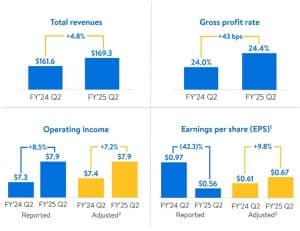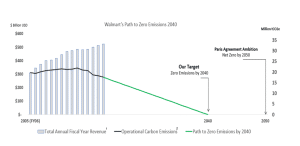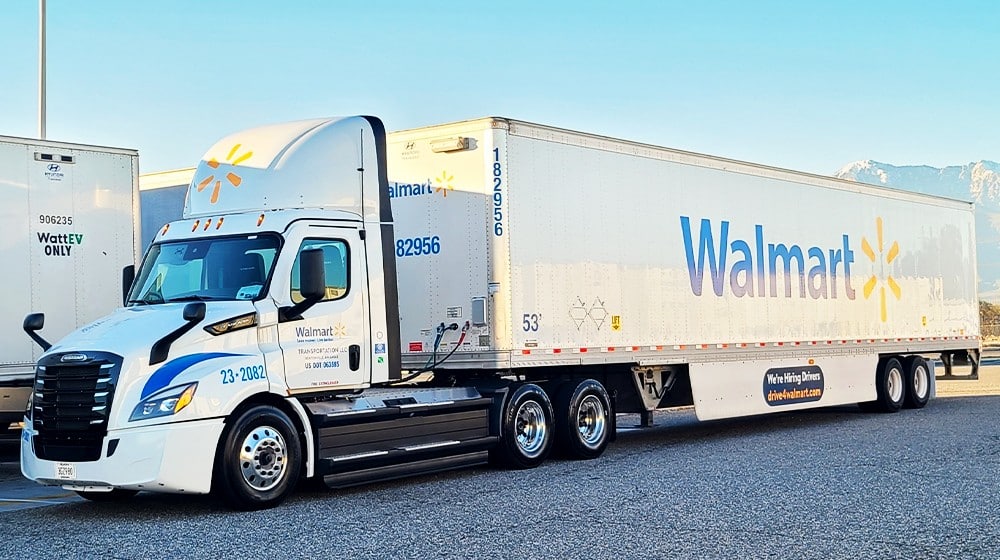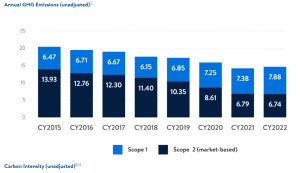America’s favorite retail outlet, Walmart, released its earnings on August 15, indicating a fantastic revenue and sales surge. However, its emissions slightly increased from the 2015 baseline. Nevertheless, the company is balancing its profits and sustainability in a commendable way.
Walmart’s Q2 2025: Revenue Up, eCommerce Soars!
Walmart Inc. reported a solid 4.8% increase in revenue for Q2 2025, reaching $169.3 billion. eCommerce sales saw a remarkable 21% growth worldwide, reflecting Walmart’s expanding digital reach. The company’s operating income rose by 8.5%, with adjusted operating income up 7.2%. This growth was driven by improved gross margins, higher membership income, and reduced e-commerce losses.
The press release further mentions, Walmart’s GAAP EPS came in at $0.56. Adjusted EPS, which excludes a net loss on equity and other investments, was $0.67. This exceeded analysts’ expectations of $0.65, marking a notable 3.08% surprise.

Key Performance Metrics
- U.S. Comparable Store Sales: Walmart U.S. saw a 4.2% increase, outperforming the 3.5% average estimate.
- Walmart International Sales Growth: Increased by 7.1%, slightly below the 7.7% estimate.
- Sam’s Club Comparable Store Sales: Up 5.2%, surpassing the 4% estimate.
- Total U.S. Comparable Store Sales: Grew by 4.3%, exceeding the 3.7% estimate.

Looking ahead, Walmart expects Q3 net sales to grow between 3.25% and 4.25%, with operating income rising by 3.0% to 4.5% in constant currency. For the full fiscal year 2025, net sales are projected to increase by 3.75% to 4.75%, with adjusted operating income growing by 6.5% to 8.0%.
Overall, Walmart’s strong performance across various segments, including eCommerce and membership, highlights its robust business model and positive outlook.
Emissions Elevate Slightly Despite Bold Net Zero Ambitions
Walmart aims for zero emissions in global operations (Scopes 1 & 2) by 2040. The company targets a 1.5-degree Celsius trajectory for climate action, with interim goals to cut Scope 1 and 2 emissions by 35% by 2025 and 65% by 2030 from 2015 levels.
source: Walmart
Since 2015, Walmart has reduced Scope 1 and 2 emissions by 21.2% and carbon intensity by 43.5%. However, in 2022, Scope 1 emissions rose by 7.6% and Scope 2 emissions rose by 0.3% (market-based), totaling to emission spike of 4.1%. Emissions rose slightly due to increased use of onsite fuels, shifts in transportation, and slower renewable energy expansion. So how Walmart is planning to cut down its emissions? Discover below.
Renewable Energy and Energy Efficiency
By the end of 2022, Walmart had over 600 renewable energy projects across 10+ countries and plans to expand its solar generation in the coming years. It has secured PPAs for over 2 GW of renewable energy and has become the top retailer in terms of green power. It focuses on community solar projects for low-to-moderate-income areas and supports various renewable energy projects through coalitions.
Speaking of efficiency, they optimize energy use through real-time monitoring and upgrade old equipment with energy-efficient systems. Additionally, they aim to install energy meters in all stores across the U.S.
Electrification of its Transport
In 2022, Walmart’s fleet accounted for 24% of Scope 1 emissions. Thus, 100% electrification of its fleet including class 8 trucks became crucial to achieve the net zero goals. Although the company is not expecting to curb emissions massively, they are adopting zero-emissions technologies, scalable solutions, and implementing supportive policies.
Tackling Stationary Fuel Emissions
In 2022, stationary fuels made up 23% of Walmart’s Scope 1 emissions, rising 21% from 2021. Cold weather in the U.S., droughts in China, and power outages in South Africa increased their reliance on heating and backup generators. These challenges highlight the need for greater energy efficiency and cleaner power. Walmart is responding by adding electrical connections for refrigerated trailers to cut diesel use.
Mitigating Onsite Refrigerants
In 2022, onsite refrigerants made up 53% of Walmart’s Scope 1 emissions. Walmart reduced global refrigerant emissions by 2% through leak management using low-GWP (Global Warming Potential) systems. They took serious steps to maintain equipment to minimize leaks and replaced old systems with low-GWP alternatives like CO2 and ammonia.
Slashing Emissions through Project Gigaton
Through Project Gigaton, Walmart helps suppliers set and achieve their emissions reduction goals. Launched in 2017, the initiative offers guidance, workshops, and resources to support these efforts. Moreover, the company aims to reduce or avoid 1 billion metric tons of CO2e in product value chains by 2030. This is why they are working with groups like the World Wildlife Fund and Environmental Defense Fund. Notably, last year they avoided more than 175 MMT of CO2e through Project Gigaton.

- KNOW MORE: Walmart Issues $2 Billion Green Bonds
In conclusion, Walmart President and CEO Doug McMillon applauded the efforts by remarking,
“Our team delivered another strong quarter. They work hard every day to help our customers and members save time and money. Each part of our business is growing – store and club sales are up, eCommerce is compounding as we layer on pickup and even faster growth in delivery as our speed improves. Our newer businesses like marketplace, advertising, and membership, are also contributing, diversifying our profits and reinforcing the resilience of our business model.”
- FURTHER READING: Is Amazon’s Carbon Goal Enough to Offset Its Financial Hiccups?



